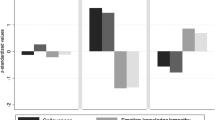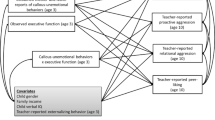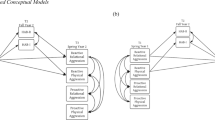Abstract
Although prior research suggests that children show rapid change in socioemotional functioning and aggression throughout early childhood, little is known about how these factors may be associated with the development of callous-unemotional (CU) features. This study investigated the parallel development of, and reciprocal relationships between, emotion understanding (EU) and aggression across early childhood, as well as how they play a role in the development of CU features. Parallel latent growth curve modeling was used to examine longitudinal reciprocal relationships between EU and aggression in a sample of 498 primarily Black (i.e., African-American or Afro-Caribbean) preschoolers (49.5% male, 89.2% Black, Mage = 4.1), followed with six waves over a 45-month period from pre-kindergarten through grade 2. CU features were included as a baseline covariate, as well as an outcome, of EU and aggression growth factors. Children with lower levels of EU at age 4 displayed higher linear increases in aggression over time. EU at age 4 had a significant indirect effect on CU features at age 8 via its association with linear increases in aggression. Findings suggest that EU is influential in the early development of aggression, which may in turn influence the development or exacerbation of CU features. Children’s EU in early childhood, especially concerning others’ distress, may be an important component of preventive intervention efforts for young children at risk for serious antisocial behavior.


Similar content being viewed by others
References
American Psychiatric Association. (2013). Diagnostic and statistical manual of mental disorders: DSM-5. Washington, D.C.: American Psychiatric Association.
Anastassiou-Hadjicharalambous, X., & Warden, D. (2008). Cognitive and affective perspective-taking in conduct-disordered children high and low on callous-unemotional traits. Child and Adolescent Psychiatry and Mental Health, 2, 1–11.
Arsenio, W. F., Cooperman, S., & Lover, A. (2000). Affective predictors of preschoolers' aggression and peer acceptance: Direct and indirect effects. Developmental Psychology, 36, 438–448.
Bedford, R., Wagner, N. J., Rehder, P. D., Propper, C., Willoughby, M. T., & Mills-Koonce, R. W. (2017). The role of infants’ mother-directed gaze, maternal sensitivity, and emotion recognition in childhood callous unemotional behaviours. European Child & Adolescent Psychiatry, 26, 947–956.
Bierman, K. L., Domitrovich, C. E., Nix, R. L., Gest, S. D., Welsh, J. A., Greenberg, M. T., et al. (2008). Promoting academic and social-emotional school readiness: The head start REDI program. Child Development, 79, 1802–1817.
Blair, R. R., Monson, J., & Frederickson, N. (2001). Moral reasoning and conduct problems in children with emotional and behavioural difficulties. Personality and Individual Differences, 31, 799–811.
Brotman, L. M., Gouley, K. K., Chesir-Teran, D., Dennis, T., Klein, R. G., & Shrout, P. (2005). Prevention for preschoolers at high risk for conduct problems: Immediate outcomes on parenting practices and child social competence. Journal of Clinical Child and Adolescent Psychology, 34, 724–734.
Brotman, L. M., Dawson-McClure, S., Calzada, E. J., Huang, K., Kamboukos, D., Palamar, J. J., & Petkova, E. (2013). Cluster (school) RCT of ParentCorps: Impact on kindergarten academic achievement. Pediatrics, 131, e1521–e1529.
Burke, J. D., Loeber, R., & Lahey, B. B. (2007). Adolescent conduct disorder and interpersonal callousness as predictors of psychopathy in young adults. Journal of Clinical Child and Adolescent Psychology, 36, 334–346.
Centifanti, L. M., Meins, E., & Fernyhough, C. (2016). Callous-unemotional traits and impulsivity: Distinct longitudinal relations with mind-mindedness and understanding of others. Journal of Child Psychology and Psychiatry, 57, 84–92.
Dadds, M. R., Fraser, J., Frost, A., & Hawes, D. J. (2005). Disentangling the underlying dimensions of psychopathy and conduct problems in childhood: A community study. Journal of Consulting and Clinical Psychology, 73, 400–410.
Dadds, M. R., Allen, J. L., Oliver, B. R., Faulkner, N., Legge, K., Moul, C., et al. (2012a). Love, eye contact and the developmental origins of empathy v. Psychopathy. The British Journal of Psychiatry, 200, 191–196.
Dadds, M. R., Cauchi, A. J., Wimalaweera, S., Hawes, D. J., & Brennan, J. (2012b). Outcomes, moderators, and mediators of empathic-emotion recognition training for complex conduct problems in childhood. Psychiatry Research, 199, 201–207.
Dadds, M. R., Kimonis, E. R., Schollar-Root, O., Moul, C., & Hawes, D. J. (2018). Are impairments in emotion recognition a core feature of callous-unemotional traits? Testing the primary versus secondary variants model in children. Development and Psychopathology, 30, 67–77.
Datyner, A., Kimonis, E. R., Hunt, E., & Armstrong, K. (2016). Using a novel emotional skills module to enhance empathic responding for a child with conduct disorder with limited prosocial emotions. Clinical Case Studies, 15, 35–52.
Dawson-McClure, S., Calzada, E., Huang, K., Kamboukos, D., Rhule, D., Kolawole, B., et al. (2015). A population-level approach to promoting healthy child development and school success in low-income, urban neighborhoods: Impact on parenting and child conduct problems. Prevention Science, 16, 279–290.
Denham, S. A. (1986). Social cognition, prosocial behavior, and emotion in preschoolers: Contextual validation. Child Development, 57, 194–201.
Denham, S. A., Caverly, S., Schmidt, M., Blair, K., DeMulder, E., Caal, S., et al. (2002). Preschool understanding of emotions: Contributions to classroom anger and aggression. Journal of Child Psychology and Psychiatry, 43, 901–916.
Eggum, N. D., Eisenberg, N., Kao, K., Spinrad, T. L., Bolnick, R., Hofer, C., et al. (2011). Emotion understanding, theory of mind, and prosocial orientation: Relations over time in early childhood. The Journal of Positive Psychology, 6, 4–16.
Eisenberg, N., Murphy, B. C., & Shepard, S. (1997). The development of empathic accuracy. In W. Ickes (Ed.), Empathic accuracy (pp. 73–116). New York, NY: Guilford Press.
Ezpeleta, L., Osa, N. l., Granero, R., Penelo, E., & Domènech, J. M. (2013). Inventory of callous-unemotional traits in a community sample of preschoolers. Journal of Clinical Child and Adolescent Psychology, 42, 91–105.
Fanti, K. A., & Kimonis, E. (2017). Heterogeneity in externalizing problems at age 3: Association with age 15 biological and environmental outcomes. Developmental Psychology, 53, 1230–1241.
Fanti, K. A., Colins, O. F., Andershed, H., & Sikki, M. (2017). Stability and change in callous-unemotional traits: Longitudinal associations with potential individual and contextual risk and protective factors. American Journal of Orthopsychiatry, 87, 62–75.
Fontaine, N. G., Rijsdijk, F. V., McCrory, E. P., & Viding, E. (2010). Etiology of different developmental trajectories of callous-unemotional traits. Journal of the American Academy of Child & Adolescent Psychiatry, 49, 656–664.
Fontaine, N. G., McCrory, E. P., Boivin, M., Moffitt, T. E., & Viding, E. (2011). Predictors and outcomes of joint trajectories of callous–unemotional traits and conduct problems in childhood. Journal of Abnormal Psychology, 120, 730–742.
Frick, P. J. (2004). The inventory of callous-unemotional traits. University of New Orleans: Unpublished rating scale.
Frick, P. J., & Hare, R. D. (2001). Antisocial process screening device. Toronto: Multi-Health Systems.
Frick, P. J., Ray, J. V., Thornton, L. C., & Kahn, R. E. (2014). Annual research review: A developmental psychopathology approach to understanding callous-unemotional traits in children and adolescents with serious conduct problems. Journal of Child Psychology and Psychiatry, 55, 532–548.
Garner, P. W., Jones, D. C., & Miner, J. L. (1994). Social competence among low-income preschoolers: Emotion socialization practices and social cognitive correlates. Child Development, 65, 622–637.
Gillen, C. A., Lee, Z., Salekin, K. L., Iselin, A. R., Harrison, N. A., Clark, A. P., et al. (2018). Psychopathic traits in adolescence: The importance of examining components in face processing, voice processing, and emotional skill. Journal of Psychopathology and Behavioral Assessment, 40, 50–59.
Gilliam, W., Maupin, A., Reyes, C., Accavitti, M., & Shic, F. (2016). Do early educators’ implicit biases regarding sex and race relate to behavior expectations and recommendations of preschool expulsions and suspensions? Yale Child Study Center.
Gutman, L. M., Joshi, H., Parsonage, M., & Schoon, I. (2018). Trends in parent- and teacher-rated mental health problems among 10- and 11-year-olds in Great Britain: 1999–2012. Child and Adolescent Mental Health, 23, 26–33.
Hawes, D. J., & Dadds, M. R. (2007). Stability and malleability of callous-unemotional traits during treatment for childhood conduct problems. Journal of Clinical Child and Adolescent Psychology, 36, 347–355.
Hawes, D. J., Dadds, M. R., Frost, A. J., & Hasking, P. A. (2011). Do childhood callous-unemotional traits drive change in parenting practices? Journal of Clinical Child and Adolescent Psychology, 40, 507–518.
Hinnant, J. B., & O'Brien, M. (2007). Cognitive and emotional control and perspective taking and their relations to empathy in 5-year-old children. Journal of Genetic Psychology, 168, 301–322.
Hu, L., & Bentler, P. M. (1999). Cutoff criteria for fit indexes in covariance structure analysis: Conventional criteria versus new alternatives. Structural Equation Modeling, 6, 1–55.
Hughes, C., Dunn, J., & White, A. (1998). Trick or treat? Uneven understanding of mind and emotion and executive dysfunction in 'hard-to-manage' preschoolers. Journal of Child Psychology and Psychiatry, 39, 981–994.
IBM Corp. (2013). IBM SPSS Statistics for Windows, Version 22.0. Armonk, NY: IBM Corp.
Jones, A. P., Laurens, K. R., Herba, C. M., Barker, G. J., & Viding, E. (2009). Amygdala hypoactivity to fearful faces in boys with conduct problems and callous-unemotional traits. The American Journal of Psychiatry, 166, 95–102.
Kim, J., & Cicchetti, D. (2006). Longitudinal trajectories of self-system processes and depressive symptoms among maltreated and nonmaltreated children. Child Development, 77, 624–639.
Kimonis, E. R., Frick, P. J., Boris, N. W., Smyke, A. T., Cornell, A. H., Farrell, J. M., & Zeanah, C. H. (2006). Callous-unemotional features, behavioral inhibition, and parenting: Independent predictors of aggression in a high-risk preschool sample. Journal of Child and Family Studies, 15, 745–756.
Kimonis, E. R., Frick, P. J., Cauffman, E., Goldweber, A., & Skeem, J. (2012). Primary and secondary variants of juvenile psychopathy differ in emotional processing. Development and Psychopathology, 24, 1091–1103.
Kimonis, E. R., Fanti, K. A., Anastassiou-Hadjicharalambous, X., Mertan, B., Goulter, N., & Katsimicha, E. (2016). Can callous-unemotional traits be reliably measured in preschoolers? Journal of Abnormal Child Psychology, 44, 625–638.
Kochanska, G., & Aksan, N. (2004). Conscience in childhood: Past, present, and future. Merrill-Palmer Quarterly, 50, 299–310.
Little, R. J. A., & Rubin, D. B. (2002). Introduction in statistical analysis with missing data (2nd ed.). Hoboken, NJ: Wiley.
Loeber, R., & Farrington, D. P. (2000). Young children who commit crime: Epidemiology, developmental origins, risk factors, early interventions, and policy implications. Development and Psychopathology, 12, 737–762.
Lozier, L. M., Cardinale, E. M., Van Meter, J. W., & Marsh, A. A. (2014). Mediation of the relationship between callous-unemotional traits and proactive aggression by amygdala response to fear among children with conduct problems. JAMA Psychiatry, 71, 627–636.
Lynam, D. R., Loeber, R., & Stouthamer-Loeber, M. (2008). The stability of psychopathy from adolescence into adulthood: The search for moderators. Criminal Justice and Behavior, 35, 228–243.
MacKinnon, D. P. (2008). Introduction to statistical mediation analysis. New York, NY: Taylor & Francis Group/Lawrence Erlbaum Associates.
Mardell-Czudnowski, C., & Goldenberg, D. (1998). Developmental Indicators for the Assessment of Learning (3rd ed.) (DIAL-3). Circle pines, MN: American guidance service.
Marshall, L. E., & Marshall, W. L. (2011). Empathy and antisocial behaviour. The Journal of Forensic Psychiatry & Psychology, 22, 742–759.
McLoyd, V. C. (1998). Socioeconomic disadvantage and child development. American Psychologist, 53, 185–204.
Mills-Koonce, W. R., Willoughby, M. T., Garrett-Peters, P., Wagner, N., & Vernon-Feagans, L. (2016). The interplay among socioeconomic status, household chaos, and parenting in the prediction of child conduct problems and callous–unemotional behaviors. Development and Psychopathology, 28, 757–771.
Muthén, L. K., & Muthén, B. O. (2012). Mplus user's guide (7th ed.). Los Angeles, CA: Authors.
Newcorn, J. H., Ivanov, I., Chacko, A., & Javdani, S. (2016). Aggression and violence. In M. K. Dulcan (Ed.), Dulcan's textbook of child and adolescent psychiatry (2nd ed., pp. 603–620). Arlington, VA: American Psychiatric Publishing.
O’Kearney, R., Salmon, K., Liwag, M., Fortune, C., & Dawel, A. (2017). Emotional abilities in children with oppositional defiant disorder (ODD): Impairments in perspective-taking and understanding mixed emotions are associated with high callous-unemotional traits. Child Psychiatry and Human Development, 48, 346–357.
Pons, F., Lawson, J., Harris, P. L., & de Rosnay, M. (2003). Individual differences in children's emotion understanding: Effects of age and language. Scandinavian Journal of Psychology, 44, 347–353.
Reynolds, C. R., & Kamphaus, R. W. (2004). BASC-2: Behavior assessment system for children (2nd ed.). Circle Pines, MN: American Guidance Service.
Roose, A., Bijttebier, P., Decoene, S., Claes, L., & Frick, P. J. (2010). Assessing the affective features of psychopathy in adolescence: A further validation of the inventory of callous and unemotional traits. Assessment, 17, 44–57.
Sakai, J. T., Dalwani, M. S., Gelhorn, H. L., Mikulich-Gilbertson, S. K., & Crowley, T. J. (2012). A behavioral test of accepting benefits that cost others: Associations with conduct problems and callous-unemotionality. PLoS One, 7, 1–12.
Salihovic, S., Kerr, M., Özdemir, M., & Pakalniskiene, V. (2012). Directions of effects between adolescent psychopathic traits and parental behavior. Journal of Abnormal Child Psychology, 40, 957–969.
Schwenck, C., Mergenthaler, J., Keller, K., Zech, J., Salehi, S., Taurines, R., et al. (2012). Empathy in children with autism and conduct disorder: Group-specific profiles and developmental aspects. Journal of Child Psychology and Psychiatry, 53, 651–659.
Somech, L. Y., & Elizur, Y. (2012). Promoting self-regulation and cooperation in pre-kindergarten children with conduct problems: A randomized controlled trial. Journal of the American Academy of Child & Adolescent Psychiatry, 51, 412–422.
Tolan, P. H., & Gorman-Smith, D. (1998). Development of serious and violent offending careers. In R. Loeber & D. P. Farrington (Eds.), Serious & violent juvenile offenders: Risk factors and successful interventions (pp. 68–85). Thousand Oaks, CA: Sage Publications.
Tremblay, R. E. (2006). Prevention of youth violence: Why not start at the beginning? Journal of Abnormal Child Psychology, 34, 480–486.
Tuvblad, C., Bezdjian, S., Raine, A., & Baker, L. A. (2013). Psychopathic personality and negative parent-to-child affect: A longitudinal cross-lag twin study. Journal of Criminal Justice, 41, 331–341.
Viding, E., Blair, R. R., Moffitt, T. E., & Plomin, R. (2005). Evidence for substantial genetic risk for psychopathy in 7-year-olds. Journal of Child Psychology and Psychiatry, 46, 592–597.
Viding, E., Jones, A. P., Frick, P. J., Moffitt, T. E., & Plomin, R. (2008). Heritability of antisocial behaviour at 9: Do callous-unemotional traits matter? Developmental Science, 11, 17–22.
Viding, E., Sebastian, C. L., Dadds, M. R., Lockwood, P. L., Cecil, C. M., De Brito, S. A., & McCrory, E. J. (2012). Amygdala response to preattentive masked fear in children with conduct problems: The role of callous-unemotional traits. The American Journal of Psychiatry, 169, 1109–1116.
Waller, R., & Hyde, L. W. (2017). Callous–unemotional behaviors in early childhood: Measurement, meaning, and the influence of parenting. Child Development Perspectives, 11, 120–126.
Waller, R., Gardner, F., Hyde, L. W., Shaw, D. S., Dishion, T. J., & Wilson, M. N. (2012). Do harsh and positive parenting predict parent reports of deceitful-callous behavior in early childhood? Journal of Child Psychology and Psychiatry, 53, 946–953.
Waller, R., Hyde, L. W., Grabell, A. S., Alves, M. L., & Olson, S. L. (2015). Differential associations of early callous-unemotional, oppositional, and ADHD behaviors: Multiple domains within early-starting conduct problems? Journal of Child Psychology and Psychiatry, 56, 657–666.
Waller, R., Dishion, T. J., Shaw, D. S., Gardner, F., Wilson, M. N., & Hyde, L. W. (2016). Does early childhood callous-unemotional behavior uniquely predict behavior problems or callous-unemotional behavior in late childhood? Developmental Psychology, 52, 1805–1819.
White, S. F., Marsh, A. A., Fowler, K. A., Schechter, J. C., Adalio, C., Pope, K., et al. (2012). Reduced amygdala response in youths with disruptive behavior disorders and psychopathic traits: Decreased emotional response versus increased top-down attention to nonemotional features. The American Journal of Psychiatry, 169, 750–758.
White, S. F., Briggs-Gowan, M. J., Voss, J. L., Petitclerc, A., McCarthy, K., Blair, R. R., & Wakschlag, L. S. (2016). Can the fear recognition deficits associated with callous-unemotional traits be identified in early childhood? Journal of Clinical and Experimental Neuropsychology, 38, 672–684.
Wilkinson, S., Waller, R., & Viding, E. (2016). Practitioner review: Involving young people with callous unemotional traits in treatment – Does it work? A systematic review. Journal of Child Psychology and Psychiatry, 57, 552–565.
Willoughby, M. T., Waschbusch, D. A., Moore, G. A., & Propper, C. B. (2011). Using the ASEBA to screen for callous unemotional traits in early childhood: Factor structure, temporal stability, and utility. Journal of Psychopathology and Behavioral Assessment, 33, 19–30.
Zheng, Y., Pasalich, D. S., Oberth, C., McMahon, R. J., & Pinderhughes, E. E. (2017). Capturing parenting as a multidimensional and dynamic construct with a person-oriented approach. Prevention Science, 18, 281–291.
Funding
This research was supported by the US Department of Education, Institute of Education Sciences (R305F050245 and R305A100596) and National Institute of Mental Health (NIMH) (1R01MH077331–01) to Laurie Brotman (PI). Additional support for the preparation of this work was provided by a Leading Edge Endowment Fund (LEEF) British Columbia (BC) Leadership Chair award, BC Children’s Hospital Research Institute Investigator Salary and Investigator Establishment Awards, and a Canada Foundation for Innovation award to Robert J. McMahon.
Author information
Authors and Affiliations
Corresponding author
Ethics declarations
Conflict of Interest
The authors declare that they have no conflict of interest.
Ethical Approval
All procedures performed in studies involving human participants were in accordance with the ethical standards of the institutional and/or national research committee and with the 1964 Helsinki declaration and its later amendments or comparable ethical standards.
Informed Consent
Informed consent was obtained from all individual participants included in the study.
Rights and permissions
About this article
Cite this article
Schuberth, D.A., Zheng, Y., Pasalich, D.S. et al. The Role of Emotion Understanding in the Development of Aggression and Callous-Unemotional Features across Early Childhood. J Abnorm Child Psychol 47, 619–631 (2019). https://doi.org/10.1007/s10802-018-0468-9
Published:
Issue Date:
DOI: https://doi.org/10.1007/s10802-018-0468-9




